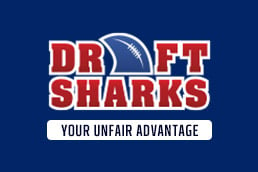What is Fantasy Football?
So you've decided to give fantasy football a try. Good.
It could be that your work league needed one more manager, or your college buddies wanted to make a league to help keep in touch. There are dozens of reasons to get into fantasy football.
It doesn’t matter why you're here. We're happy we can help you start your journey into this beautiful game we all love.
Welcome to Draft Sharks.
What is Fantasy Football - The Basics
Fantasy football is your chance to run your own football team. You'll draft real NFL players, decide who starts and who rides the bench, make trades, and work the waiver wire.
Your fantasy football team will score points based on how well your NFL players produce. Build the best team and take home a championship, bragging rights, and maybe even some cash!
The decades-old traditional fantasy football league format is called “redraft.”
It’s called “redraft” because you draft a new team every year. You will also sometimes hear it referred to as “season-long fantasy football.”
And this straight-forward league format is the entry point for most fantasy football players.
Jump to:
League Format | The Draft | Rosters & Lineups | Free Agents | Trading | Playoffs
What is Fantasy Football - League Format
Fantasy football leagues usually consist of eight or more teams, with 10- and 12-team leagues being the most popular sizes. 14- and 16-team leagues are less common and tend to be more difficult for beginner managers.
Creating an even number of teams allows the league to play head-to-head matchups every week throughout the season.
Head-to-Head Play
In a head-to-head fantasy football league, teams play against each other every week on a rotating schedule. This is the most common format and the default type on most platforms.
Each team selects a lineup of players that collects fantasy points based on the projected real-life performance of the selected NFL players.
You win if your team scores more fantasy points than your opponent’s that week. It’s that simple!
Win-loss records determine the league standings, and the top teams will advance to the playoffs. League playoffs are usually Weeks 15-17 in the NFL season and use single elimination head-to-head matchups to determine the champion.
Total Points Play
You still set a weekly lineup to collect fantasy points in this format. But rather than facing another team each week, your team simply collects points throughout the season.
The league standings are then determined by who has the most total fantasy points.
This league format usually runs without playoffs, crowning the highest-scoring team at the end of the year.
What is Fantasy Football - The Draft
Most leagues begin the season with a fantasy football draft in one of two main formats:
Snake draft or auction draft (aka salary cap draft).
Snake Draft

A snake-style (or serpentine) draft places teams in a predetermined order, then flips that order with each subsequent round.
So if you open the draft with the first pick, you’d be making the last selection in Round 2, the first selection of Round 3, the last pick of Round 4, and so on.
One challenge here:
Even with the draft order reversing by round, you can still find the earlier teams gaining an advantage.
For example: If you pick first, you’re getting three of the top 25 players that come off the board. Meanwhile, team 12 in the initial order gets player #36 with its third pick.
This isn’t a huge issue in general, and most snake-draft leagues stick with the round-by-round flipping. That includes most large fantasy football tournaments. But some leagues counter that potential advantage with a “3rd-round reversal.”
What is a 3rd-round reversal?
Instead of the draft snaking back through Round 3, it repeats the Round 2 draft order.
So the team that picked last in Round 1 would pick first in Round 2 and first in Round 3.
And then the draft order would go back to snaking the rest of the way.
Some fantasy football leagues follow linear draft order instead.
What is a linear draft?
It’s a draft that simply repeats the same order every round. Pick first overall? Then you’re picking first in every round.
You can probably see why this isn’t generally the fairest way to run a draft. The managers selecting early in the draft gain a huge advantage!
Not sure how to tackle your draft?
Our Draft War Room is designed to get your team off to the optimal start in any format.
What is ADP in fantasy football?
ADP stands for Average Draft Position in fantasy football. It is a term used to represent the average position at which a player is being drafted in fantasy football leagues (12-team PPR, 12-team non-PPR, etc.). ADP is a useful tool for fantasy football players as it provides an indication of a player's perceived value and allows for better draft strategy and player evaluation.
ADP is typically calculated by collecting data from various fantasy football drafts, either through mock drafts or real leagues. The data is then compiled to determine the average draft position for each player. This information is often available on fantasy football websites or can be obtained through draft software.
Why is ADP important?
The main purpose of ADP is to help fantasy football players understand where a player is being selected relative to other players at his position. It gives an idea of how early or late a player is being drafted and can help fantasy managers make informed decisions during their drafts.
For example, if a player has an ADP of 20, it means that, on average, he is being selected as the 20th player in fantasy drafts.
Let’s say you’re a true believer in Bears WR Rome Odunze. You think he’ll break out as a top-15 WR.
Cool – but you shouldn’t draft Odunze anywhere close to that range. Head to our fantasy football ADP Index, and you’ll see Pickens’ ADP is 4.09 (Round 4, pick 9). On average, he’s the 25th WR off the board.
So, using ADP, you can avoid over-drafting players – and ensure you’re scooping up value with each selection.
You can even use site-specific ADP to your advantage. See how that can be done on platforms like Yahoo Fantasy and ESPN Fantasy.
Auction Draft or Salary Cap Draft
What is an auction draft in fantasy football? Or a salary cap draft?
Simple. Think of what an auction is… then apply it to building your fantasy team.
One player gets nominated at a time for bidding, usually with league members taking turns nominating – or posting – a player for bidding.
Every team can then bid on that player, with the highest bid winning the player.
You start with a budget to pay player “salaries,” often $200, to fill your roster.
Every time you “win” the bidding on a player, two things happen:
- That player is now on your team, and
- The winning dollar bid you made is deducted from your budget.
So you have a shot at any player you want but must work within your predetermined budget.
The auction usually continues until every team has filled its roster.
Read more about how auction drafts work.
TIP
An auction draft involves more strategy than a snake or linear draft. Before getting started, make sure to check out our Auction Strategy Guide.
What is Fantasy Football - Rosters and Lineups

Whatever your draft type, the purpose of the fantasy football draft is to build your roster of players.
You’ll use that roster to fill a starting lineup weekly, with the non-starters making up your bench.
Most commonly, you’re starting some combination of QBs, RBs, WRs, TEs, Kickers, and Team Defense/Special Teams – with many different ways to combine them.
Fantasy Football Positions
QB | RB | WR | TE | Flex | K | DST | IDP
Quarterback (QB)
Most fantasy football leagues start one QB. You can carry a backup QB on your roster but often don’t need to if you have a high-end starter.
Another method for 1-QB leagues is “streaming.”
What does streaming in fantasy football mean?
That’s when you regularly pick up players off waivers to start at a particular position.
In leagues of 10 teams or fewer, you can often find enough QB options on the waiver wire weekly to pick up a guy with the best combination of production and matchup.
Does streaming work in larger leagues?
Streaming QBs can even work in 12-team fantasy football leagues, though it depends more on how many QBs your league mates roster.
We wouldn’t recommend trying it in leagues of more than 12 teams.
Some fantasy football leagues start 2 QBs or use a Superflex position. These formats return value to the QB position, which loses value vs. reality in the traditional 1-QB format.
What is Superflex?
That’s when your lineup includes a flex position where you can play a second QB or a player from another position, usually RB, WR or TE.
TIP
If you love watching QBs score points, you might be ready to join a “superflex” league. You can read more about playing in superflex leagues here.
Superflex puts a premium on QBs
Because QBs are almost always the highest scorers across fantasy football formats, you’ll want to try to play a second QB in that superflex spot.
Making that lineup spot superflex instead of just a second QB offers you more flexibility if you don’t have a second QB to start in a given week.
Running back (RB)
Nearly all fantasy football leagues start at least one RB. In most cases, you’ll start at least two. And RBs are usually included in flex positions. We’ll look at flex spots more in a minute.
RBs were once the driving force of fantasy football. You almost needed to take one with your first pick – and likely your second one.
That’s not the case anymore, with more committee backfields throughout the NFL increasing the number of fantasy-viable RBs.
Still, you'll find plenty of RBs near the top of the fantasy football rankings.
Wide Receiver (WR)
Fantasy football lineups nearly always start multiple WRs, with two or three WR spots being the most common. WRs are nearly always included in “flex” consideration.
(You can read about the flex position below.)
And it’s the position with the most fantasy-relevant players. At this point, most NFL teams commonly run 3-WR alignments – sometimes even going beyond three.
Tight End (TE)
Most fantasy football leagues start just one TE, with another potentially in consideration for a flex position.
TEs won’t typically factor into your flex decision, though. The position doesn’t see as much reception volume as WR or touch volume as RB.
You can consider streaming TEs in some cases.
Like at QB, this is when you pick up a player off the waiver wire to start, usually because he faces a particularly good matchup.
TIP
Our weekly rankings, adjusted fantasy points allowed, and strength of schedule pages can help you find strong streaming options throughout the season.
Flex Position
Your league might use a flex position (or more than one) to add a starting-lineup spot without requiring it to come from a specific position.
Most commonly, a “flex” player can be any RB, WR or TE. A "superflex" spot can be filled by a QB.
Kicker (K)
Kickers remain a part of most fantasy football leagues. However, they have started to disappear from more formats in recent seasons.
Kickers get fantasy points for every extra point and field goal (FG) made, usually with more credit for longer FGs.
This is one of the least important positions in fantasy football and can be filled at the end of your draft. Do not waste a high pick on a kicker!
Team Defense & Special Teams (DST)
This is just what it sounds like. You play the defense from one NFL team in your lineup each week.
You derive points from that team’s defensive performance and nearly always from the special teams. However, this does not include field goals or extra points since those points fall under the kicker position.
So in most cases, you only get special-teams points when that NFL team scores a TD on a kickoff or punt return. (Some leagues do award points for return yardage as well.)
Team Defense points are most commonly scored with sacks, interceptions, and fumble recoveries. Some fantasy leagues also award points based on how many points and/or yards your defense allows.
DST should almost always be streamed.
This is the easiest position to stream.
Very few team defenses score consistently well, so you’re usually better off targeting defenses with good matchups. This also means you should wait until the end of your drafts to address the position.
TIP
Find out who's the best defense for fantasy this season.
Individual Defensive Players (IDP)
Instead of team defenses, some fantasy football leagues use IDP.
In this format, you start a certain number of defensive players along with the offensive players: some combo of defensive linemen, linebackers, and defensive backs.
These defenders score fantasy points for categories such as tackles, sacks, pass breakups, and turnover plays.
The Lineup
In most fantasy football formats, you’ll select a weekly starting lineup from your full roster of players. The most common alignment includes:
- 1 QB
- 2 RBs
- 2-3 WRs
- 1 TE
- 1 Flex
- 1 K
- 1 DST
There is always room for your fantasy football league to vary from that norm, either to make things more challenging or to simplify the format for less-experienced players.
Whatever your specific lineup settings, the players in your starting lineup will collect points for you in a given week. The remaining players on your roster make up your bench (or reserves).
How to get the most points out of your lineup.
We'll be honest: Start-sit decisions can keep you up at night. Panicked, you wake up at 3 am. Should you start Nameless WR over Faceless RB in your flex? Wrong decision. You lose by less than a single point. Completely preventable. Life is pain.
Here's where we can help. Take the guesswork out of your start sit decisions and check out our Team Intel Tool.
Built on our 3D Projections
Best Ball is the easiest format to play.
There is another format known as “best ball.”
What is best ball fantasy football?
This format has you draft a roster just like you do in a traditional fantasy football league.
But instead of you deciding who to start every week, the league-hosting site will automatically select your top scorers at each position to calculate your fantasy points for the week.
So, for example ...
Suppose your league is set to start:
- 1 QB
- 2 RBs
- 3 WRs
- 1 TE
- 1 Flex
- 1 K
- 1 DST
In that case, you’ll automatically get credit for the highest QB score on your roster for that week, the two highest-scoring RBs, the three highest-scoring WRs, the highest-scoring TE, K, and DST, and then the highest remaining scorer among your RBs, WRs, and TEs (to fill the flex).
TIP
Since best ball is the easiest fantasy football format, consider joining a best ball league this summer. You can learn more about best ball format and strategy.
What is Fantasy Football - Free Agents
How to Work Your Waiver Wire
Players who are not selected in your league’s draft will automatically become free agents. Every league format can handle free agents a little differently. We will go over the basics to help you out.
First Come, First Served (FCFS)
This style of handling free agents puts no limits on when teams can acquire available players.
There are benefits to having some portion of in-season weeks run this way.
Let’s say, for example, you find out Sunday morning that one of your RBs won’t be playing because of injury.
The only other RB available on your bench is on bye. Without FCFS free agency, you might have to take a 0 for that spot.
Chaos can be part of the free agent pickup!
The potential downside of only handling free agents this way is that it can create a free-for-all atmosphere.
If one or two owners in your league are always on the computer – or smartphone – then they’re likely to reap an advantage in snapping up players whose value suddenly spikes on some breaking news.
Of course, getting the jump on your competition when news breaks can be helpful in even the best free-agent setups.
Timely and actionable fantasy football news is crucial.
That’s why we update our Shark Bites news section whenever important news breaks.
We give you the news PLUS a quick take on how to take advantage of what just happened. Timely and actionable.

And if you subscribe to our email list, you’ll get the most important fantasy news sent to your inbox throughout the year.
Waiver Wire
The term waiver wire – or waivers – is often used interchangeably with general free agency in fantasy football leagues.
But a “waiver” refers to your claim on a freely available player. And there are different ways to handle such claims.
Waiver Priority
This system ranks every team in the league for priority in claiming free agents, just like the NFL does.
This priority might be set in reverse of league draft order. It might also rank teams from worst to best on season record.
In either case, “using” your priority to claim a player will usually drop you to the bottom of the priority list for the next run.
That mixes in some strategy of deciding how much you want a given player.
TIP
Read more about our waiver wire strategy.
FAAB or Blind-Bid Waivers
What is FAAB in fantasy football?
FAAB stands for free agent acquisition budget. Many leagues use a system with a full-season budget and weekly “blind-bid” or “FAAB” waiver runs.
That’s when every team in the league is free to enter an amount they would pay to acquire a specific freely available player in a given week.
The highest bid wins that player, and the bid amount is deducted from your full-season waiver budget. (It’s not hard to see how strategy comes into play.)
Hybrid rules sometimes work best.
The optimal way to handle free agents in single fantasy football leagues is likely some combo of waivers and FCFS.
The former keeps the “always-on” guy from snatching the surprise producers in each week’s NFL games.
The latter keeps you from taking a 0 when Sunday morning news catches you off-guard.
TIP
Whatever your format, we post our top waiver-wire recommendations each week during the season. And the Free Agent Finder highlights the top available options (every week) in your league.
What is Fantasy Football - Trading
The free-agent market won’t always provide what you need to help your fantasy football team. Frankly, it shouldn’t.
If it's that easy to mine the waiver-wire for roster-boosting pieces, then you’re probably ready to move up to a more challenging league.
Trades can help your fantasy team in a variety of ways.
You can often get a bigger jolt this way because you’re acquiring a better player than what’s freely available on the market.
You can also weaken an opponent by swiping a player due a production spike ( “buy low”).
Ideally, you can achieve both goals while also unloading a guy who has been running lucky and is in for a fall in production (“sell high”).
Trading makes fantasy fun. But it can be difficult and a little scary. Let us help you trade with confidence.
Our Trade Navigator tool can help you find the optimal trading partner and evaluate a potential deal before you make it.
Don’t trade before you know the details.
TIP
You can read more about our Trade Philosophy here.
What is Fantasy Football - Playoffs
You don’t need playoffs to determine the champion in your fantasy football league. But most leagues do.
Generally, the top few teams – that number can vary by format – after 14-16 weeks of the “regular season” advance to the playoffs and then battle head-to-head over the final 2-3 weeks.
We strongly recommend avoiding Week 18 of the NFL season with your league schedule
With their NFL seeding determined, many playoff teams rest starters in Week 18. That creates a messy situation for fantasy players.
And even non-playoff teams might decide to get a look at younger players or deactivate mildly injured guys who would typically suit up.
How to select playoff teams
Some fantasy football leagues select playoff teams by taking the two teams with the best records and the two remaining teams with the most total points.
There is no perfect system when striving for fairness and fun.
So if you’re in a new league or setting one up yourself, we’d recommend finding a format that works best for your group.
Final Thought
Now that you know the answers to “what is fantasy football,” it might be a good time to think about another question: “How can I win at fantasy football?”
Here’s what we think is the straight answer: To win your league today, you must focus first on your draft. And to do that – you need a real-time draft tool that walks you through every pick of your draft.
It doesn’t matter if you want to try a best ball league, superflex league, auction league, or even a traditional redraft league – you need a tool to help you figure out which players to pick.
How You Can Win With Our Draft War Room







